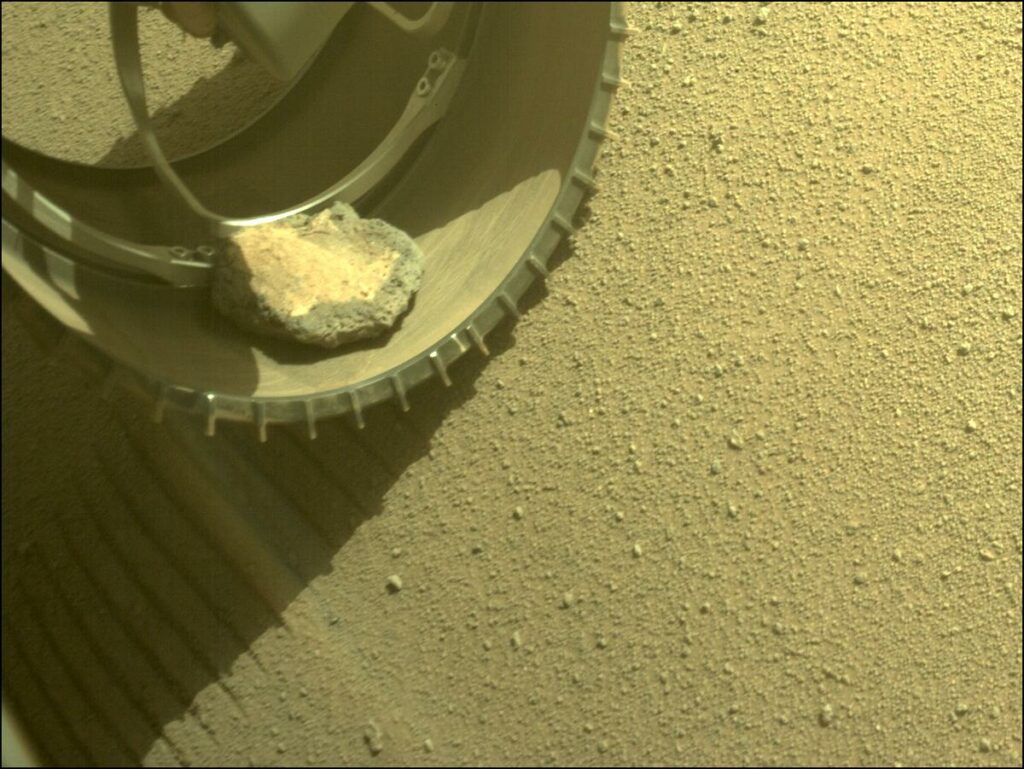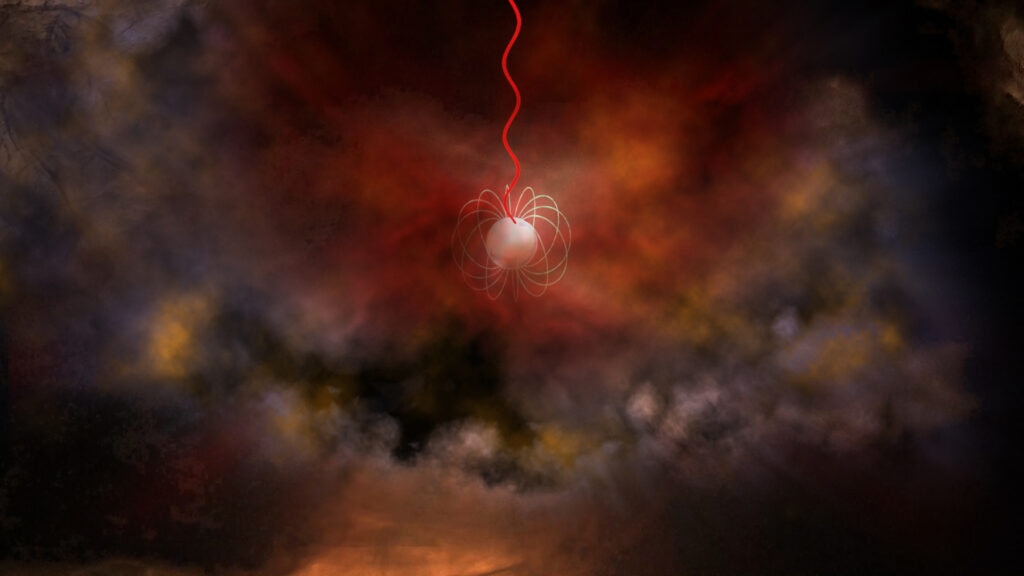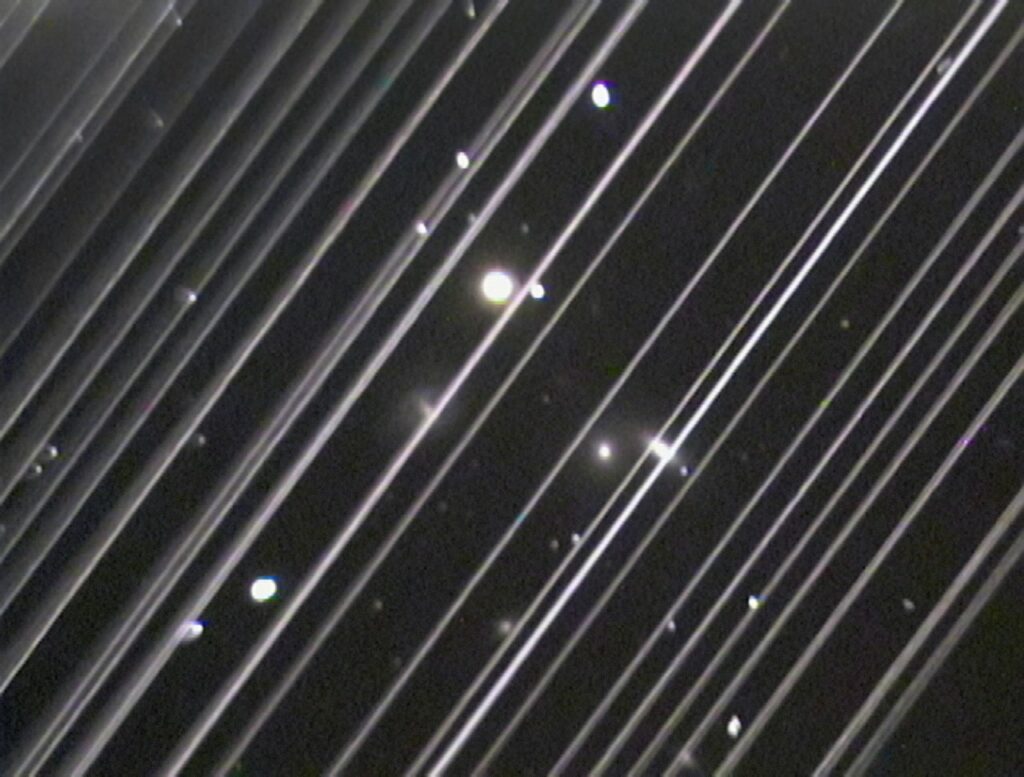A second repeating fast radio burst was detected in 2019 by China’s FAST observatory and confirmed in 2020 by the Very Large Array. This latest discovery raises the possibility that there are two different types of FRBs. Plus, a SpaceX commercial launch, mission updates, neutron stars, and this week’s What’s Up.
Podcast
Show Notes
SpaceX launches commercial satellite
- Thales Alenia Space press release
- SpaceX press release
- Launch video
JWST mirror hit by micrometeorite
- Webb: Engineered to Endure Micrometeoroid Impacts (NASA)
- How Hardy Is Webb? A Q&A About the Toughness of NASA’s Webb Telescope (NASA)
Ingenuity faces another challenge
- NASA status update
Percy and its pet rock
- Perseverance Has a Pet Rock! (NASA)
Radio loud star lumbers lazily
- SARAO press release
- “Discovery of a radio-emitting neutron star with an ultra-long spin period of 76 s,” Manisha Caleb et al., 2022 May 30, Nature Astronomy
Second repeating Fast Radio Burst discovered
- NRAO press release
- “A repeating fast radio burst associated with a persistent radio source,” C.-H. Niu et al., 2022 June 8, Nature
Look up while you still can – the “stars” are changing
- ‘Unsustainable’: How Satellite Swarms Pose a Rising Threat to Astronomy (Scientific American)
What’s Up: The Planets
- Planet Parade to Grace the Dawn Sky This Month (Sky & Telescope)
Transcript
Did you hear?
What?
It turns out that SpaceX can launch things that aren’t Starlink or Dragon into orbit!
And did you know that there might be two different types of Fast Radio Bursts?
I did not, but I do know What’s Up in the sky in the coming week.
All of this and more, right here on the Daily Space.
I am your host Dr. Pamela Gay.
And I am your host Erik Madaus.
And we’re here to put science in your brain.

On June 8 at 21:04 UTC, a SpaceX Falcon 9 launched the Nilesat-301 satellite from SLC-40 at the Cape Canaveral Space Force Station. Like many communications satellites, Nilesat-301 was bound for Geostationary Transfer Orbit, GTO. Most SpaceX launches these days, such as Dragons and Starlinks, go to low Earth orbit, so it’s nice to see satellites destined for higher orbits. This means the webcasts are longer so we get more live views from the rocket cameras.
Booster 1062 was on its seventh flight and successfully landed on the drone ship Just Read The Instructions, stationed almost 700 kilometers downrange in the Atlantic Ocean. This particular booster previously flew on two GPS III launches, Ax-1, Inspiration 4, and two Starlink missions, according to SpaceX.
After a twenty-minute coast phase, the second stage restarted for a one-minute burn to send the satellite to its geostationary transfer orbit, with an apogee high up at over 35,000 kilometers. A couple of minutes later, Nilesat-301 was released to begin its journey. The satellite will take a few weeks to get to its final orbit, and then it can begin its fifteen-year operational life.
Nilesat-301 is the seventh satellite built for Egyptian company Nilesat Co. Built by Thales Alenia Space, the satellite weighed about four metric tons at launch, but remember, most of that is fuel to get it the rest of the way to geostationary orbit. Nilesat will offer communications and television services throughout all of Africa and part of the Middle East.

Meanwhile, over at L2, things got a little interesting for our still-dead-to-me telescope, JWST. It seems that sometime between May 23 and 25, the mirror segment labeled C3 sustained an impact from a micrometeorite. However, before anyone either panics or cackles with glee, initial assessments have shown that the telescope is still exceeding mission requirements.
Also, don’t cackle with glee. Scientists are depending on this telescope for data.
Micrometeorites are an expected and natural hazard of hanging about in space, and JWST’s mirror was engineered to withstand these impacts. Not only was extensive engineering and testing performed before launch, but the mirror segments can be adjusted to make corrections in the event of these impacts.
Now, not all of the damage can be negated, which is why there are also mitigation procedures in place to minimize these strikes. For example, the flight team will maneuver the optics away from known meteor showers before passing through the dust field. But the operations team expects some telescope degradation over time. Optical telescope element manager Lee Feinberg notes: Since launch, we have had four smaller measurable micrometeoroid strikes that were consistent with expectations and this one more recently that is larger than our degradation predictions assumed. We will use this flight data to update our analysis of performance over time and also develop operational approaches to assure we maximize the imaging performance of Webb to the best extent possible for many years to come.
This largest impact will have no effect on the operations schedule or the upcoming release of JWST’s first science images on July 12.

Over on Mars, the situation for our favorite little Martian helicopter has taken a turn for the worse. Winter is coming, and that had already been a huge concern as dust storms increase, sunlight decreases, and Ingenuity’s solar panels and battery are not standing up to the strain. To cope with the seasonal change, Ingenuity is being shut down during the night to conserve power. However, this new program means that the electronic components aren’t being heated during the cold Martian nights, either.
And now one of the navigation sensors – the inclinometer – has failed. This particular sensor is used to determine the direction of gravity prior to take-off to make sure the launch direction is correct. The inclinometer is not an in-flight sensor, but it is necessary to get into flight.
Fortunately, NASA engineers design lots of possible redundancies into spacecraft – even test drones on other planets – in case something fails. For Ingenuity, that means that a different sensor – the inertial measurement unit – can be used to impersonate the inclinometer… just with less accuracy. The operations team believes that using this method will still allow for a safe take-off, which means our helicopter can continue flying.
For as long as the solar power holds out, of course.
And now for some rather silly news from Mars. NASA’s Perseverance rover has, it seems, a pet rock. You heard that correctly. Percy has a pet rock.

Back in early February, on sol 341, a lumpy rock found its way into the wheel well of Percy’s front left wheel. And it has been hitching a ride on the rover ever since, traveling more than 8.5 kilometers to date. Despite the oftentimes bumpy journey, the rock has continued to hang in there, appearing occasionally in the left Hazcam pictures. Most recently, the rock was seen sol 449, May 26, still hanging out in Percy’s left front wheel.
One of the best parts of this story is that, at some point, the rock is going to exit the building… er, rover. And maybe someday, some poor Martian geologist or grad student will find it where it doesn’t belong and wonder how in the world it got there.
Personally, I think we need to name Percy’s friend, so feel free to share your suggestions with us. And we’ll have links to some of the images of said friend in our show notes at DailySpace.org.
Coming up next, I’m going to talk about a new fast radio burst and the science of neutron stars.

One of the easiest pits to fall into as an astronomer is designing surveys to see what is expected and thus totally missing what’s unknown. This was a trap that a team of researchers using the MeerKAT telescope to look for transients and pulsars almost fell into. With their instrument – named MeerTRAP – mounted alongside another imaging instrument, they were looking for your standard, high-speed events — stars spinning hundreds of times a second, bursts that last the briefest of moments. Essentially, they were looking for radio blips that tell stories of the low-energy side of the universe.
And when you are looking for things that can happen hundreds of times a second, you don’t normally look at any one object all that long. Unless you’re ridesharing with an imaging instrument intent on staring at things.
It was in this kind of a piggyback, along-for-the-ride situation that MeerTRAP found a pulsar that rotates every 76 seconds. This rotational period is so slow that initial observations only caught one pulse. Previously, no pulsars had been spotted rotating this slow.
It is unclear if the lack of prior detections is due to this being a rare object or our own lack of patience.
These results are published in Nature Astronomy with first author Manisha Caleb, who explains: Amazingly we only detect radio emission from this source for 0.5% of its rotation period. This means that it is very fortuitous that the radio beam intersected with the Earth. It is therefore likely that there are many more of these very slowly spinning sources in the Galaxy which has important implications for how neutron stars are born and age. The majority of pulsar surveys do not search for periods this long and so we have no idea how many of these sources there might be. In this case, the source was bright enough that we could detect the single pulses with the MeerTRAP instrument at MeerKAT.
This means that alongside the crazy fast, never-ending drumroll of your standard pulsar, we now know there are lumbering stars, more lazily keeping a slower beat.
And we have to wonder what else are we missing because we just don’t look slowly enough?

Neutron stars are one of the weirdest things out there. When massive enough stars die, their outer layers explode away as supernovae while their leftover cores collapse down. The cores are massive, and without the pressure from ongoing nuclear reactions pushing outward, gravity is able to crush them so tightly that protons and electrons can’t exist separately, and the entire thing collapses into just neutrons. Depending on the exact circumstances of both the initial collapse and the surrounding environment, the resulting dead star may be rapidly spinning like a pulsar. It may have a powerful magnetic field and be called a magnetar, and it may be both.
And it may, sometimes, emit millisecond-long flashes of radio emission, giving off a fast radio burst (FRB).
And a neutron star that repeatedly gives off fast radio bursts has been found with a companion that gives off constant, faint, radio emissions.
And this is the second neutron star like this we’ve found.
And in astronomy, two of a thing count as a trend, so it appears that fast radio bursting neutron stars may come with companions that softly emit radio all the time.
Fast radio bursts are a fairly new discovery, and we don’t know much about them yet. Being able to precisely locate them on the sky and then figure out their environments is going to be key to advancing our understanding. Environments can alter how we see things, and in this case, they can also alter where we see things to be.
In general, when a radio pulse travels through the universe, different colors of light can travel through material at different speeds. In a vacuum, light moves at the speed of light, but when going through clouds of electrons, higher frequency light travels faster than lower frequency light. This spreads out as a pulse, and if we know the density of electrons between us and a distant object, the amount that we see the light dispersed can tell us where the radio pulse originated.
With this object, we can see it is located in a galaxy only a few billion light-years away, but the normal dispersion technique indicates it is 8-9.5 billion light-years away. According to team researcher Kshitij Aggarwal: This means that there is a lot of material near the FRB that would confuse any attempt to use it to measure the gas between galaxies. If that’s the case with others, then we can’t count on using FRBs as cosmic yardsticks.
Essentially, the material around the source is faking us out and leading us to believe the object is simply farther away. And now when we find object three, we have to hope we can also see where it is through some other means. But first, we have to find object three.
This work is published in Nature Astronomy with first author C-H Niu.
And seeing things is just going to keep getting harder as more and more satellites go up and more and more antennas and other radio sources are built here on the ground.

Before we get to this week’s “What’s Up” segment, I want to call your attention to a piece in the latest issue of Scientific American that points out that if the currently planned communications constellations like Starlink and OneWeb are completed, one in roughly every fourteen points of light in the sky will actually be a satellite. The way they phrased it was “one in every fourteen stars visible to the naked eye will actually be a satellite.”
After the initial realization that Starlink satellites will wreak havoc on telescopic images, SpaceX agreed to alter their satellite designs so the tiny comsats would reflect less sunlight back to Earth and would appear fainter in the images they affect. The new design was a noticeable improvement, but the most recent launches have stopped using that design; SpaceX is back to the more reflective designs of the past, and it is unclear what has changed.
The pandemic has made dealing with this issue particularly hard. First brought to light at the January 2020 American Astronomical Society meeting in Hawaii, astronomers have been trying to sort out what is going on without the freedom to easily travel or even full access to observatories. As things open up, our profession is gearing up for the tri-annual meeting of the International Astronomical Union. Alongside that meeting will be the launch of websites to help researchers plan their astronomical images around satellites and new tools for folks to collaborate with in trying to convince companies to build missions that cause less light pollution. Some of these websites are up now, and we will link to them at Daily Space.org.
And as I’ve said before, go out and look up before one in fourteen stars is actually a satellite. We have an awesome lineup of things you should go see.
What’s Up

The Twitch audience won’t see the lower third, but viewers watching us on NowMedia will now realize how much of a classical music dork I am.
Anyway, as the summer goes on, we’re getting to the point where the planets are easier to see. If you’re in the northern hemisphere, look to the southeast on the morning of Friday, June 24, where Venus, Mars, Mercury, Jupiter, Saturn, and the Moon will all be in a line in the sky before sunrise. According to Sky & Telescope, the five planets will span 107 degrees of the sky. This alignment also happened earlier in the month, and if you wait a bit, Mercury will be even easier to see.
A couple of other miscellaneous events for the next week: Venus is 1.6 degrees from Uranus on June 11. Mercury will be at its greatest eastern elongation on June 16, and this will be the best time to see it in the evening hours. Finally, the asteroid Vesta will pass within seven-tenths of a degree from the Moon on June 19.
Most of the planets are visible with the unaided eye, so just head on outside and take a look. If you want to see Uranus or Vesta, however, you’ll need at least a small telescope and a finding chart. We recommend using the free software Stellarium.
This has been the Daily Space.
You can find more information on all our stories, including images, at DailySpace.org. As always, we’re here thanks to the donations of people like you. If you like our content, please consider joining our Patreon at Patreon.com/CosmoQuestX.
Credits
Written by Pamela Gay, Beth Johnson, Erik Madaus, and Gordon Dewis
Hosted by Pamela Gay, Beth Johnson, and Erik Madaus
Audio and Video Editing by Ally Pelphrey
Content Editing by Beth Johnson
Intro and Outro music by Kevin MacLeod, https://incompetech.com/music/


 We record most shows live, on Twitch. Follow us today to get alerts when we go live.
We record most shows live, on Twitch. Follow us today to get alerts when we go live.